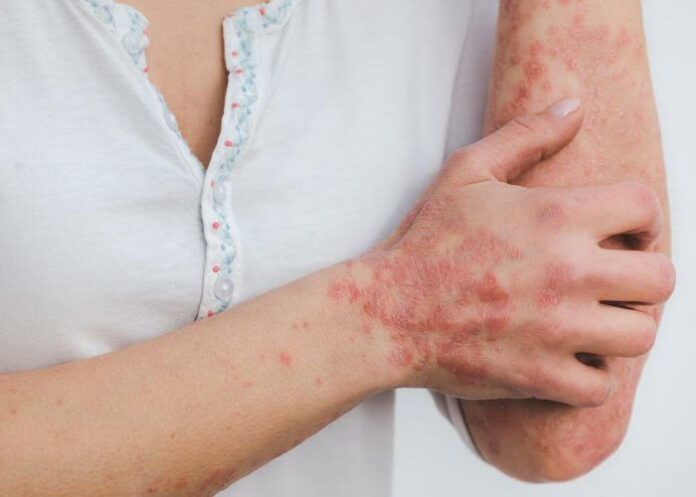As part of a study, a MedUni Vienna research team has now discovered a key starting point for inhibiting inflammation in both psoriasis and psoriatic arthritis. The researchers’ findings may form the basis for developing new treatment, diagnostic and prevention strategies.
The study, conducted by the research group led by Erwin Wagner (Department of Dermatology and Department of Laboratory Medicine, MedUni Vienna), focused on the S100A9 gene, which has long been at the centre of its internationally acclaimed scientific research into psoriasis. The team has discovered that the severity of psoriasis (Ps) and psoriatic arthritis (PsA) can be reduced by inhibiting S100A9 systemically throughout the whole body rather than locally on the skin.
With this finding, the researchers are laying the foundation for a paradigm shift in the treatment of Ps and PsA: “Our study is an important step towards the development of targeted therapeutic options in the form of drugs that act systemically rather than locally on the skin,” said Wagner. New diagnostic and prevention strategies can also build on the study.
Deciphered in preclinical experiments
Psoriasis is one of the most common chronic inflammatory skin conditions that can also spread to the joints. Triggers for the disease, which usually first appears in adulthood, include stress and UV radiation. However, individuals can also be genetically predisposed to developing Ps. S100A9 activation in skin and immune cells has been identified as a risk factor for the development of Ps and/or PsA.
As shown by previous basic research by Wagner’s team at MedUni Vienna, the symptoms of psoriasis disappear when the S100A9 gene is deactivated in all cells of the body. The recent preclinical experiments were able to shed light on the particular influence that the skin and immune cells in which S100A9 is produced have on disease severity.
“We now know that the inflammatory responses in psoriasis and psoriatic arthritis are enhanced when S100A9 is only inhibited in skin cells,” Wagner said, summarising the main finding of the study. Therefore drugs inhibiting S100A9 have to be administered systemically in the form of tablets or drips.
Study details
Keratinocyte-derived S100A9 modulates neutrophil infiltration and affects psoriasis-like skin and joint disease.
Liliana F Mellor, Nuria Gago-Lopez, Latifa Bakiri, Felix N Schmidt, Björn Busse, Simon Rauber, Maria Jimenez, Diego Megías, Sergio Oterino-Soto, Ricardo Sanchez-Prieto, Sergei Grivennikov, Xinzhu Pu, Julia Oxford, Andreas Ramming, Georg Schett, Erwin F Wagner.
Published in BMJ’s Annals of the Rheumatic Diseases (ARD) 2022.
Abstract
Objectives
S100A9, an alarmin that can form calprotectin (CP) heterodimers with S100A8, is mainly produced by keratinocytes and innate immune cells. The contribution of keratinocyte-derived S100A9 to psoriasis (Ps) and psoriatic arthritis (PsA) was evaluated using mouse models, and the potential usefulness of S100A9 as a Ps/PsA biomarker was assessed in patient samples.
Methods
Conditional S100A9 mice were crossed with DKO* mice, an established psoriasis-like mouse model based on inducible epidermal deletion of c-Jun and JunB to achieve additional epidermal deletion of S100A9 (TKO* mice). Psoriatic skin and joint disease were evaluated in DKO* and TKO* by histology, microCT, RNA and proteomic analyses. Furthermore, S100A9 expression was analysed in skin, serum and synovial fluid samples of patients with Ps and PsA.
Results
Compared with DKO* littermates, TKO* mice displayed enhanced skin disease severity, PsA incidence and neutrophil infiltration. Altered epidermal expression of selective pro-inflammatory genes and pathways, increased epidermal phosphorylation of STAT3 and higher circulating TNFα were observed in TKO* mice. In humans, synovial S100A9 levels were higher than the respective serum levels. Importantly, patients with PsA had significantly higher serum concentrations of S100A9, CP, VEGF, IL-6 and TNFα compared with patients with only Ps, but only S100A9 and CP could efficiently discriminate healthy individuals, patients with Ps and patients with PsA.
Conclusions
Keratinocyte-derived S100A9 plays a regulatory role in psoriatic skin and joint disease. In humans, S100A9/CP is a promising marker that could help in identifying patients with Ps at risk of developing PsA.
See more from MedicalBrief archives:
Western diet rich in fat and sugar linked to skin inflammation and psoriasis
New drug helps control symptoms in psoriatic arthritis patients
Tx shows ‘significant recovery’ in psoriasis

